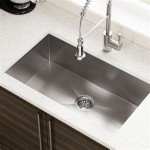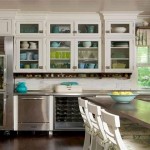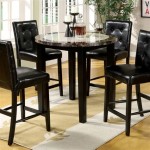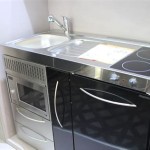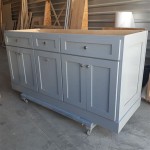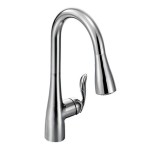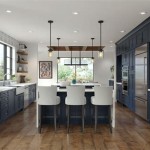Kitchen Faucet With Deck Plate: A Comprehensive Guide
A kitchen faucet with a deck plate is a common and versatile plumbing fixture found in many homes. Its primary function is to deliver water for various kitchen tasks, including washing dishes, rinsing produce, and filling pots. The deck plate, a crucial component of this type of faucet, provides a stable and aesthetically pleasing base that covers existing sink holes and offers options for mounting the faucet and its accompanying accessories.
Understanding the different aspects of kitchen faucets with deck plates can assist homeowners in making informed decisions regarding selection, installation, and maintenance. This article will explore the key features, benefits, types, and considerations related to these faucets, providing a detailed overview for anyone considering an upgrade or replacement.
Understanding the Deck Plate's Function
The deck plate, also sometimes referred to as an escutcheon plate, serves multiple purposes beyond simply covering pre-drilled holes in the sink or countertop. Its primary purpose is indeed to conceal unused holes from previous faucet installations, presenting a clean and finished look. However, the deck plate also contributes to the faucet's stability and structural integrity.
By spreading the weight and pressure exerted on the faucet across a wider surface area, the deck plate reduces the risk of damage to the sink or countertop. This is particularly important for heavier, more elaborate faucet designs. The deck plate also facilitates the mounting of accessories such as side sprayers, soap dispensers, or even air gaps, further enhancing the functionality of the kitchen sink area.
Deck plates are available in diverse materials, finishes, and styles to complement a variety of kitchen designs. The choice of material, such as stainless steel, brass, or even composite materials, contributes to the faucet's overall durability and resistance to corrosion. The finish, ranging from polished chrome to matte black, allows homeowners to match the faucet to existing kitchen hardware and appliances. The style of the deck plate, whether minimalist, traditional, or modern, further enhances the aesthetic appeal of the sink area.
Key Benefits of Using a Kitchen Faucet with a Deck Plate
Choosing a kitchen faucet with a deck plate offers a range of advantages. These faucets are generally easier to install compared to single-hole faucets, especially when replacing an existing faucet setup with multiple holes. The deck plate simplifies the installation process by eliminating the need to fill or cover unused holes individually.
Aesthetically, deck plates offer a more refined and integrated look. They provide a seamless transition between the faucet base and the sink or countertop, creating a polished and professional appearance. The availability of diverse styles and finishes allows homeowners to customize the faucet to match their kitchen décor, enhancing the overall visual appeal of the space.
Furthermore, the added stability provided by the deck plate extends the lifespan of the faucet. By distributing the weight and pressure, the deck plate reduces the strain on the faucet's components, minimizing the risk of leaks, wobbling, or other forms of damage. This can translate into long-term cost savings by reducing the need for repairs or replacements.
Finally, cleaning and maintenance are often easier with a faucet mounted on a deck plate. The smooth, continuous surface of the deck plate eliminates crevices and hard-to-reach areas where dirt and grime can accumulate. This simplifies the cleaning process and helps to maintain a hygienic kitchen environment.
Types and Styles of Kitchen Faucets with Deck Plates
Kitchen faucets with deck plates are available in a wide array of types and styles to suit various needs and preferences. The following are some of the most common types:
Pull-Down Faucets: These faucets feature a sprayer head that can be pulled down from the spout, providing extended reach and flexibility for washing and rinsing. They are particularly useful for cleaning large pots and pans or for rinsing produce in hard-to-reach areas of the sink. The deck plate provides a stable base for the faucet and often incorporates a docking mechanism to secure the sprayer head when not in use.
Pull-Out Faucets: Similar to pull-down faucets, pull-out faucets feature a sprayer head that can be extended from the spout. However, instead of pulling down, the sprayer head pulls out horizontally. This design is often preferred for smaller sinks or for users who prefer a more ergonomic grip. The deck plate serves the same purpose of providing stability and covering existing holes.
Two-Handle Faucets: These traditional faucets feature separate handles for controlling hot and cold water. They offer a classic and timeless aesthetic and are often preferred for their simplicity and ease of use. The deck plate is typically wider to accommodate the two handles and the spout, providing a substantial and balanced appearance.
Single-Handle Faucets: Single-handle faucets use a single lever to control both water temperature and flow. They are known for their convenience and ease of operation, allowing users to adjust the water with one hand. The deck plate for a single-handle faucet can be smaller than that of a two-handle faucet, providing a more minimalist look.
Beyond these basic types, kitchen faucets with deck plates are also available in a variety of styles, ranging from traditional and ornate to modern and minimalist. The choice of style depends on the overall aesthetic of the kitchen and the personal preferences of the homeowner. Popular styles include farmhouse, contemporary, industrial, and transitional.
Materials and Finishes
The materials used in the construction of a kitchen faucet with a deck plate significantly impact its durability, performance, and aesthetic appeal. The most common materials include:
Brass: Brass is a durable and corrosion-resistant material that is often used for the internal components of faucets. It is known for its ability to withstand high water pressure and temperature fluctuations.
Stainless Steel: Stainless steel is another popular choice for kitchen faucets due to its durability, corrosion resistance, and hygienic properties. It is also relatively easy to clean and maintain.
Zinc Alloy: Zinc alloy is a more affordable alternative to brass and stainless steel. While it is less durable, it can still provide adequate performance for many homeowners. It is often used for the external components of faucets.
The finish of a kitchen faucet refers to the surface treatment applied to the exterior of the faucet. The finish not only enhances the aesthetic appeal of the faucet but also provides protection against corrosion and wear. Common finishes include:
Chrome: Chrome is a classic and versatile finish that is known for its durability and reflectivity. It is a popular choice for both traditional and modern kitchens.
Brushed Nickel: Brushed nickel is a warm and inviting finish that offers a subtle sheen. It is a good choice for kitchens with a more rustic or farmhouse aesthetic.
Oil-Rubbed Bronze: Oil-rubbed bronze is a dark and rich finish that evokes a sense of elegance and sophistication. It is often used in traditional or Victorian-style kitchens.
Matte Black: Matte black is a modern and stylish finish that adds a touch of drama to any kitchen. It is a popular choice for contemporary and industrial-style kitchens.
Considerations for Installation and Maintenance
Installing a kitchen faucet with a deck plate is generally a straightforward process, but it is important to follow the manufacturer's instructions carefully. Before beginning the installation, make sure to turn off the water supply to the sink. It is also advisable to wear gloves to protect your hands. The tools required for installation typically include a wrench, screwdriver, and plumber's tape.
When installing the deck plate, make sure it is properly aligned with the sink or countertop holes. Apply a bead of sealant or caulk around the edges of the deck plate to create a watertight seal. Connect the water supply lines to the faucet and tighten the connections securely. Test the faucet for leaks before completely finishing the installation.
Regular maintenance is essential to keep your kitchen faucet with a deck plate functioning properly and looking its best. Clean the faucet regularly with a mild soap and water solution. Avoid using abrasive cleaners or scouring pads, as these can damage the finish. Periodically check the faucet for leaks and address any issues promptly. Replacing worn-out washers or O-rings can often resolve minor leaks.
For faucets with pull-down or pull-out sprayers, it is important to occasionally clean the sprayer head to remove mineral deposits or debris. Follow the manufacturer's instructions for cleaning the sprayer head. Depending on water hardness, consider using a water softener to minimize scale buildup on the faucet and other plumbing fixtures. With proper care and maintenance, a kitchen faucet with a deck plate can provide years of reliable service.

Flg Single Handle Pull Down Sprayer Kitchen Faucet With Deck Plate Stainless Steel Commercial Sink Taps In Brushed Nickel Dd 0083 Bn

Spot Free Antique Champagne Broe Finish 18 Inch Kitchen Faucet

Forious Hh0024b Single Handle Kitchen Faucet With Pull Down Function Sprayer Sink Deck Plate In Matte Black

Project Source Wakebridge Polished Chrome Single Handle Kitchen Faucet Deck Plate And Side Spray Included 67103w 1301 At Lowes Com

Project Source Brice Polished Chrome Double Handle Deck Mount Kitchen Faucet Plate Included Side Sprayer 67129w 1001

Elkay Everyday Three Hole Deck Mount Kitchen Faucet With Lever Handle And Plate Escutcheon Chrome

Newater Single Handle Pull Down Kitchen Faucet With Deck Plate Supply Lines Matte Black 9001011

Forious Single Handle Kitchen Faucet With Pull Down Sprayer High Arc Sink Deck Plate In Chrome Hh0023ch

Commercial Pull Down Pre Rinse Spring Sprayer Polished Chrome Kitchen Sink Faucet With Deck Plate Solid Brass Homary

B K Mueller Deck Plate Mount Kitchen Faucet With Spray Msc Direct

